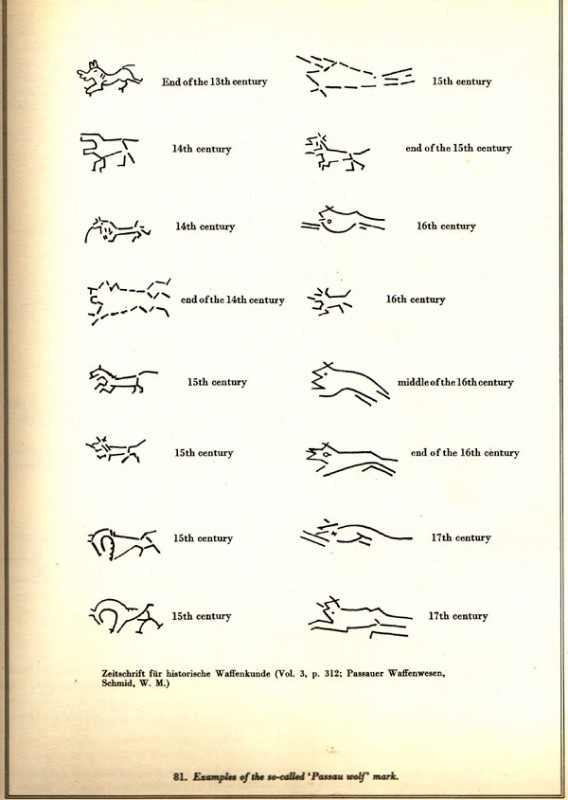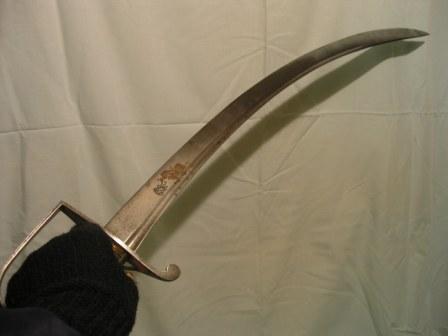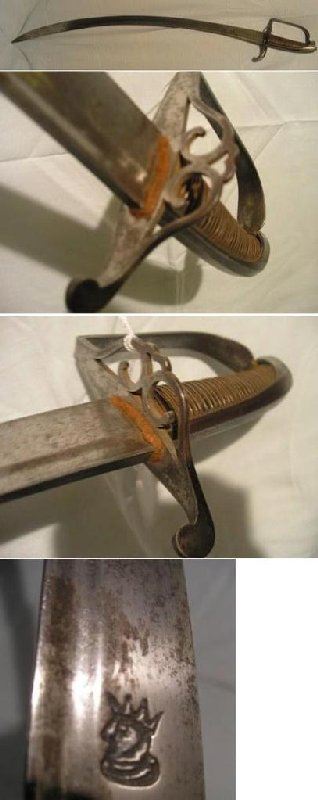| Author |
Message |
|
Antony Karasulas
Location: Australia Joined: 05 Jun 2014
Posts: 4
|
 Posted: Thu 05 Jun, 2014 8:12 am Post subject: Identify a Passau Wolf blade Posted: Thu 05 Jun, 2014 8:12 am Post subject: Identify a Passau Wolf blade |
 |
|
Hello all. My first post 
I have a sword that has been re-hilted in Czarist Russia (hilt-maker Skosiryev), but the blade is clearly older and I think not Russian. The blade is evidently made of forge-folded steel, and has a Passau Running Wolf engraved on both sides of the blade. Each wolf has 4 star and the letters MH on either side of it. Does anyone know anything about the likely provenance of this blade?
Thanks,
Tony
 Attachment: 144.74 KB Attachment: 144.74 KB
[ Download ]
 Attachment: 77.63 KB Attachment: 77.63 KB
[ Download ]
|
|
  |
 |
Glen A Cleeton

|
 Posted: Thu 05 Jun, 2014 10:12 am Post subject: Posted: Thu 05 Jun, 2014 10:12 am Post subject: |
 |
|
Hi Anthony
It can be invaluable to share more than a snippet of blade when hoping for an ID. You appear to be showing a sabre blade of indefinite proportion. my first guess is that the wolf might be spurious, as the general form belongs to an earlier century than the blade type.
Please post pictures of the entire sword and provide some dimensions. It is more than a one hundred to one shot that someone will have an answer, even with that information added.
Cheers
GC
 Attachment: 62.36 KB Attachment: 62.36 KB

|
|
  |
 |
|
Antony Karasulas
Location: Australia Joined: 05 Jun 2014
Posts: 4
|
 Posted: Thu 05 Jun, 2014 11:09 pm Post subject: Posted: Thu 05 Jun, 2014 11:09 pm Post subject: |
 |
|
Thanks Glen.
Here are some pics of the whole sword. The blade is otherwise unmarked, but it is clear to me it is an older blade than the Tzarist hilt attached to it (the hilt has a small and refined maker's name and a double-headed eagle stamped on it). I know little about Russian swords, but have handled a fair few antique swords of other provenance. This sword seems to have been shortened, or reshaped after breaking, as the fullers disappear right off the tip, but this appears to have been done at the time of re-hilting or before, as the scabbard is a very close fit and it's parts clearly match the hilt fittings. So, my guess is an older imported blade reshaped and refitted for Imperial Russian service. I am interested in a best guess of the blade's origins.
Thanks again.
 Attachment: 166.99 KB Attachment: 166.99 KB
[ Download ]
 Attachment: 224.4 KB Attachment: 224.4 KB
[ Download ]
 Attachment: 228.18 KB Attachment: 228.18 KB
[ Download ]
 Attachment: 213.41 KB Attachment: 213.41 KB
[ Download ]
|
|
  |
 |
Luka Borscak

|
 Posted: Fri 06 Jun, 2014 2:32 am Post subject: Posted: Fri 06 Jun, 2014 2:32 am Post subject: |
 |
|
|
It looks to me like the blade has been shortened in the tip area, so we don't know how the top part looked when new...
|
|
  |
 |
Glen A Cleeton

|
 Posted: Fri 06 Jun, 2014 2:43 am Post subject: Posted: Fri 06 Jun, 2014 2:43 am Post subject: |
 |
|
The blade could be as late as the early 19th century and the wolf/fox mark used in Solingen as much as it had been in Passau. It was a guild mark. Pages 20 and 21 have some interesting tidbits.
http://books.google.com/books?id=5sEDAAAAMAAJ
Cheers
GC
|
|
  |
 |
|
Antony Karasulas
Location: Australia Joined: 05 Jun 2014
Posts: 4
|
 Posted: Fri 06 Jun, 2014 2:28 pm Post subject: Posted: Fri 06 Jun, 2014 2:28 pm Post subject: |
 |
|
Thanks Glen.
However, I do not understand how to use the link you pasted in your reply. I gather that you are referring to the article 'Inscribed Mottoes etc on Arms and Armour' by Robert Brydall but do not see how to access the article.
Cheers,
Tony
|
|
  |
 |
Glen A Cleeton

|
 Posted: Fri 06 Jun, 2014 5:39 pm Post subject: Posted: Fri 06 Jun, 2014 5:39 pm Post subject: |
 |
|
The link should go to the complete tome and then search within or "preview this book"
Pasted below for all reader's convenience
Another kind of inscription can only be referred to here in a general way, as to treat of it fully would not only require very special qualifications, but space at least equal to a whole volume of the Transactions; that is the marks, names, and monograms of the makers and places of manufacture. That weapons bore these marks in very early times is proved by the existence of an iron Roman sword-blade in the Museum of Artillery in Paris, which bears the smith's mark, "Sabini." In a previous communication to the Society I mentioned the fact that Ferrara blades did not necessarily mean that these so marked were the work of the Ferrara family only, as it became merely a kind of trade mark indicating a superior quality of blade, whether German or Italian. In Germany, as far back as the thirteenth century, the cities of Passau and Solingen were famous for the production of sword blades, and early in the fourteenth century a celebrated armourer of Passau named Springenklee received from the Emperor Charles IV. a coat of arms bearing two crossed swords to be used by his township. The mark of the wolf, or running fox, as it is sometimes called, which is commonly associated with Solingen blades, was common to those of Passau as well, especially in the thirteenth century; it is supposed to have been granted to the Armourers' Guild of Passau by the Archduke Albrecht in 1349. Until the custom was suppressed by the French, Solingen had a stamp office in its large market place, where the smiths were obliged to bring their work to have it proved and stamped. Toledo blades being often preferred to those made in Germany, the German smiths often imitated the Toledo marks; and when the smith of one town wrought in another, the work of the new guild under which he wrought of course appears on his work. As examples of the latter, three very fine swords in Windsor Castle bear the unicorn's head of Nurnberg, the blades of which are the work of Clemens Horn of Solingen; one of these was made for King Charles I. when Prince of Wales, and has a long inscription in Latin with the Royal Arms, the Prince of Wales' feathers, and the date 1610. Another example occurs in the case of the Colman family, who removed from Basel to Augsburg about 1377, when their mark of a close helmet, surmounted by a cross, had the Augsburg badge and guild mark. Although numerous devices appear upon arms and armour indicating the maker, names and monograms are more frequent and more modern.
Spain, on account of its abundant supplies of the finest iron ore in the world, was celebrated for its weapons from the time of the Punic wars, and had the advantage of the services of the Moorish workers in steel, who were masters of the craft The names and marks of the armourers of Toledo, who were famous, with those of Seville, Saragossa, and Saint Clement, from the second half of the sixteenth century till the eighteenth, have been collected by Don Manuel Rodriguez Palaminto from the records of Ayuntamiento. The Toledo smiths also wrought at Madrid, Cordova, Cuenca, Bilbao, and other places; and their marks, which are often enclosed in a cartouche, consist of an initial or a badge, such as open scissors, a goat, or a wolf, often surmounted by a crown. A form of the wolf is appropriately used by Lupus Aguado. In the Armeria Real of Madrid many specimens have beautiful marks of the armourers working in that city after 1684, some of which are German; these marks are usually accompanied by the name on a separate square, the latter usually surmounted by a crown. For example, Diego Albarez has the name beneath a crown accompanied by his mark, a tower with two flags projecting and a lion's head; Diego Ventura's mark is a dog worrying a bird; Juan de Soto has a galloping horse; Miguel Zegava, a dog or fox eating off a tree, surmounted by a crown; Antonio Gomez, a unicorn, etc
Italy, of course, more particularly the city of Milan, was famous for its steel arms and armour, usually inscribed with the maker's name or badge. Florence afterwards became a great rival to Milan, while Brescia was also famed for its steel. Blades and handles of swords were often made in different workshops, indeed it was probably always so in the case of very fine handles, and in the splendid collection at Vienna many of the swords have German hilts with Italian blades, while others have Solingen blades with Milanese hilts.
Although France must have produced some skilful armourers, their names are almost unknown, with a few exceptions, till after the beginning of the seventeenth century. In England the names of the makers of the fine war and tilting helmets, which are remarkable for their great thickness and solidity of steel, are unknown, otherwise that country produced no native armourers of any importance. In Scotland whatever arms were made were of the ordinary kind, and almost no makers' names are known except by tradition, such as the Moncurs of Dundee, till firearms came into use; of these arms the most famous were the Highland pistols, the manufacture of which is said to have been introduced into Doune about the year 1646 by Thomas Caddell, although earlier specimens are known.
The relevant paragraphs shared here
Cheers
GC
|
|
  |
 |
Glen A Cleeton

|
 Posted: Fri 06 Jun, 2014 5:49 pm Post subject: Posted: Fri 06 Jun, 2014 5:49 pm Post subject: |
 |
|
| Luka Borscak wrote: | | It looks to me like the blade has been shortened in the tip area, so we don't know how the top part looked when new... |
Something like this, circa 1750. One of mine.
Cheers
GC
 Attachment: 9.12 KB Attachment: 9.12 KB

 Attachment: 13.91 KB Attachment: 13.91 KB

|
|
  |
 |
|
Antony Karasulas
Location: Australia Joined: 05 Jun 2014
Posts: 4
|
 Posted: Sat 07 Jun, 2014 7:07 am Post subject: Posted: Sat 07 Jun, 2014 7:07 am Post subject: |
 |
|
Interesting article, thanks for posting it Glen.
What is the provenance of the sword you showed?
Tony
|
|
  |
 |
Glen A Cleeton

|
 Posted: Sat 07 Jun, 2014 8:13 am Post subject: Posted: Sat 07 Jun, 2014 8:13 am Post subject: |
 |
|
| Antony Karasulas wrote: | Interesting article, thanks for posting it Glen.
What is the provenance of the sword you showed?
Tony |
A German blade, a Swedish hilt. Although not entirely conclusive, the blade probably marked by one of the Wundes family.
Cheers
GC
 Attachment: 39.31 KB Attachment: 39.31 KB

|
|
  |
 |
|
|
You cannot post new topics in this forum
You cannot reply to topics in this forum
You cannot edit your posts in this forum
You cannot delete your posts in this forum
You cannot vote in polls in this forum
You cannot attach files in this forum
You can download files in this forum
|
All contents © Copyright 2003-2025 myArmoury.com — All rights reserved
Discussion forums powered by phpBB © The phpBB Group
Switch to the Basic Low-bandwidth Version of the forum
|

